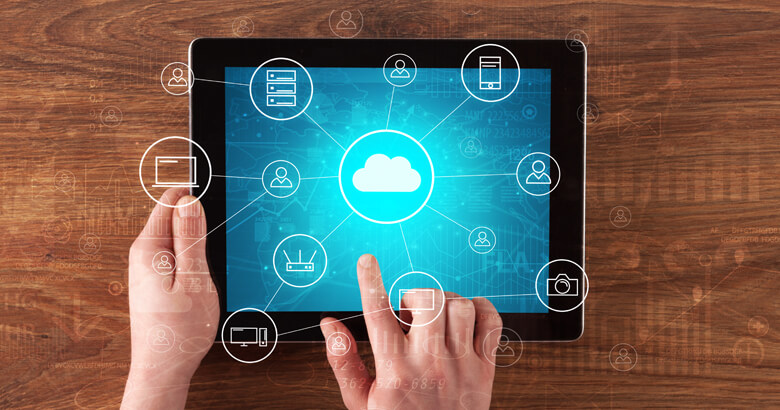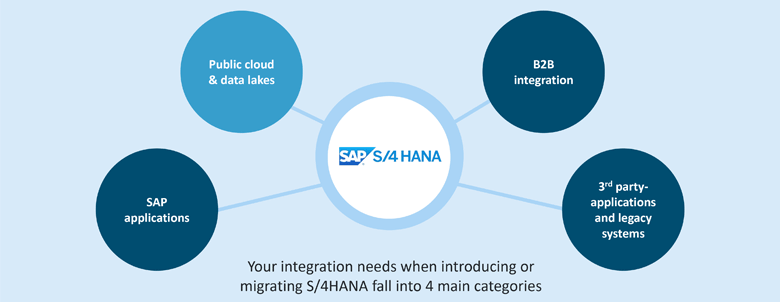
When implementing SAP S/4HANA, the endpoints to be integrated vary depending on factors such as an organisation’s IT landscape, industry, and cloud and digital strategies. In this blog series, we are looking at four main areas in SAP S/4HANA integration:
- 3rd party applications and legacy systems
- B2B integration
- Public clouds and data lakes
- SAP applications
This article is looking at integrating SAP S/4HANA with public clouds and data lakes.
 Figure 1: Integrating SAP S/4HANA with public clouds and data lakes
Figure 1: Integrating SAP S/4HANA with public clouds and data lakesIntegrating S/4HANA with public clouds and data lakes – highest data availability for information acquisition
The importance of integrating public clouds has grown as more companies have started using them. The focus in this integration area is not on applications and systems, although there are hyperscalers who run these in the public cloud. The exciting, more significant use of these hyperscale environments is creating data lakes and using the tools available for analytics, machine learning (ML), IoT and artificial intelligence (AI).
Big Data is a topic which starting growing in prominence just a few years ago. Open Source solutions such as Apache Spark, Apache Hadoop and Apache HBase helped generate a lot of the interest. They opened up previously unimagined possibilities for companies to turn big data into information. Everyone could now become a little bit like Google, using the data which exists in abundance in every company.
The key was the ability to store and manage data in simple structures. This means that you no longer needed to define a structural model in advance, as was the case for conventional databases or data warehouses. Instead, it is defined at the moment of access. This simplicity and flexibility made it possible to analyse mass data whenever you wished, and to keep asking new questions of the same dataset. One exciting example of this is what can be achieved with the sensor data collected from federal highways, described in our article Big Data, IoT and SEEBURGER.
At the same time, people stated getting excited by such possibilities as predictive maintenance, something IoT and sensor data make possible. These days, it is mobility data getting the attention, with modern cars producing 25GB of data an hour and self-driving cars 4 terabytes worth a day. Although much of this data is transient, the question is what can be done with it, what patterns can be discerned, and whether it can be used to make predictions.
Integrating S/4HANA with public clouds and data lakes – how can an organisation get a grip on their data streams?
Organisations tend to quickly encounter two key hurdles:
- The sheer mass of the data: How can a single company maintain the efficient, scalable infrastructure needed to store and manage this amount of data?
- The expert knowledge needed to properly set up and manage the open source solutions used to extract information from this data mass.
It is not surprising that hyperscalers have immediately embraced this area. Providing scalable IT infrastructures – for example, for building data lakes – has become the central task of public clouds, while making analytics tools available is an easy value-adding service. A good introduction to this phenomenom can be found in this article, which looks at the examples of the AWS, AZURE, and GCP cloud data services.
Breaking down the two hurdles from above has, however, created new questions:
- How can you get the data from the data lake into the public cloud?
- How can you deal with further two-way data flow?
The answer to these two questions in the integration world is a hybrid integration platform, and SAP S/4HANA is an interesting data source. It goes without saying that S/4HANA is not the only thing the platform needs to integrate. There are several other data sources, 3rd party applications and message brokers such as JMS and KAFKA to support.
S/4HANA integration with public clouds and data lakes – multi cloud or hybrid cloud strategies solve your integration requirements
There are several methods and technologies used for integrating data lakes and public clouds. This may require event-based calls, message brokers such as JMS or Kafka, an IoT communication protocol such as MQTT, employing a NAS/NFT for streaming, or connecting an HDFS or a blob container. More details can be found by clicking on ‘Public Cloud Access Technology’ and ‘Databases and Data Storage’ on our connectors page.
These options also come into play when companies set up multi-cloud environments with hybrid IT infrastructures. Although technically this refers to using a combination of public cloud offerings, it is often used to refer to an entire IT infrastructure comprising several (internal or hosted) private or public cloud solutions and employing cloud-based applications or services. This requires hybrid cloud integration. Using the latter definition, nearly every SAP S/4HANA user company is pursuing a multi-cloud strategy, and is therefore confronted by the many integration requirements this entails:
- Multi-cloud integration between several public clouds/hyperscalers,
- Hybrid cloud integration between private clouds and public clouds/hyperscalers.
The ability to master bulk data is key to choosing the right integration platform. As an iPaaS has a pricing model based on use, moving bulk data through this often leads to unpleasant surprises as costs quickly get out of control. Hybrid integration platforms, on the other hand, which can be operated in any cloud and on-premises, are a good solution as they allow you to combine the efficiency of integration services with calculable and controllable costs.
Find out more about the SEEBURGER solutions for integrating SAP S/4HANA and have a look at our blog posts covering the things you need to consider in this mammoth task. For one thing’s for sure: S/4HANA integration is best left to the experts.
Source: https://blog.seeburger.com/integrating-s-4hana-with-public-clouds-data-lakes/
 sap-combine.com
sap-combine.com
